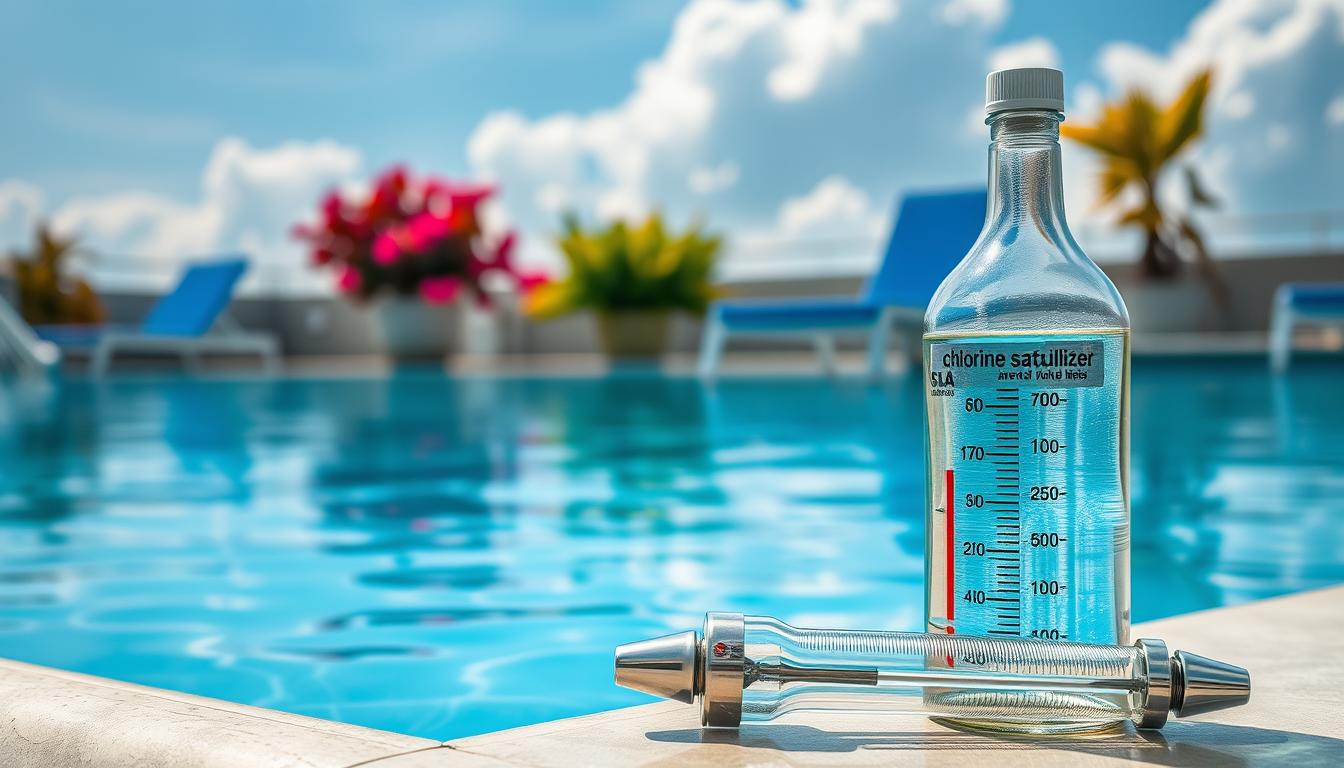
Is your pool’s cyanuric acid (CYA) level too high? High CYA can reduce chlorine effectiveness and cause algae growth. Let’s explore easy ways to lower stabilizer without draining your pool.
We’ll discuss methods to reduce cyanuric acid levels and maintain proper pool stabilizer levels. These pool maintenance tips will help you avoid draining while keeping your pool safe.
Balancing pool chemicals is vital for safe swimming. Several options exist to lower stabilizer in pool without draining. We’ll guide you through effective ways to reduce CYA levels.
From reverse osmosis systems to gradual dilution, you can manage chlorine stabilizer control. These methods help maintain your pool without the hassle of draining.
Key Takeaways
- High CYA levels can reduce chlorine effectiveness and lead to algae growth
- Ideal CYA levels range between 30-50 ppm for optimal pool performance
- Mobile filtration systems, like reverse osmosis, can lower CYA levels without draining the pool
- Dilution strategies and cyanuric acid reducer products offer alternative methods to reduce cyanuric acid
- Regular testing and monitoring of pool stabilizer levels are essential for proper pool maintenance
Understanding Cyanuric Acid (CYA) and Its Role in Pool Maintenance
Cyanuric acid (CYA) is crucial for maintaining chlorine levels in swimming pools. It shields chlorine from UV rays, keeping it active longer. CYA ensures proper pool water chemistry and balanced pool water.
Sunlight can degrade non-stabilized chlorine by 75-90% in two hours. CYA prolongs chlorine’s effectiveness by 3-5 times. It’s essential for outdoor pools exposed to high UV light.
Ideal CYA Levels for Optimal Pool Performance
For optimal pool performance, CYA levels should be between 30 to 60 ppm. Recommended levels may vary based on pool type and guidelines followed.
| Pool Type | Recommended CYA Level (ppm) | Corresponding Free Chlorine Level (ppm) |
|---|---|---|
| Fresh Water Pools | 30-50 | 2-4 |
| Saltwater Pools | 60-80 | 4.5-6 |
| Commercial Pools (CDC Guidelines) | 15 | 1-3 |
Problems Associated with High CYA Levels
High CYA levels can cause issues in pool water. It can slow down chlorine’s effectiveness, leading to chlorine lock. This makes chlorine less active in eliminating contaminants and pathogens.
Excessive CYA can lower the Langelier Saturation Index (LSI). A lower LSI indicates aggressive water, potentially causing corrosion to pool equipment. CYA also contributes to cyanurate alkalinity, affecting water balance.
The Relationship Between CYA and Free Chlorine
The ideal free chlorine (FC) level should be 7.5% of the CYA level. For example, if CYA is 50 ppm, FC should be around 3.75 ppm. This ensures proper sanitization and balanced pool water.
Stabilized chlorine products like Dichlor and Trichlor contain 50-58% CYA by weight. Regular use can increase CYA levels over time. Monitor CYA levels and make pool chemical adjustments to maintain optimal performance.
Alternative Methods to Lower Pool Stabilizer Levels
High cyanuric acid (CYA) levels can disrupt pool chemistry. Draining and refilling isn’t always practical or eco-friendly. Let’s explore some effective alternatives to reduce CYA levels without emptying your pool.
Using Reverse Osmosis (RO) Mobile Filtration Systems
RO mobile filtration systems efficiently lower CYA levels. They reduce calcium hardness, total dissolved solids, phosphates, salts, and waterborne diseases. These systems conserve up to 85% of existing pool water.
The filtered water returned to the pool is drinking-water quality. This ensures a safe and healthy swimming environment for all.
Implementing a Dilution Strategy Over Time
Gradual dilution is another method to reduce CYA levels. This involves partially draining and refilling the pool over time. It slowly lowers CYA concentration in the water.
Consistently replacing pool water with fresh, CYA-free water helps. This can bring stabilizer levels to the ideal 30-50 ppm range. It requires patience but offers a gradual approach.
Exploring Cyanuric Acid Reducer Products
Cyanuric acid reducer products contain nitrifying bacteria. These bacteria break down CYA into organic nitrogen compounds. The compounds can then be removed from the water.
These products require specific conditions to work properly. The pool must be dechlorinated before use. Water temperature must be warm enough for bacteria to thrive.
Research and follow manufacturer’s instructions carefully. This ensures the best results when using CYA reducer products.







